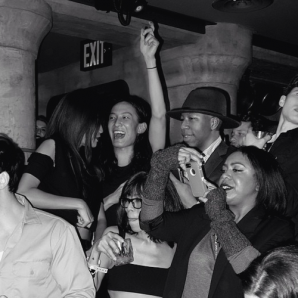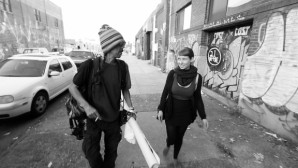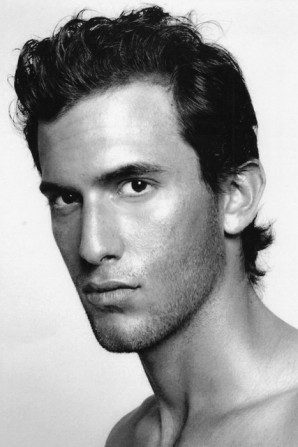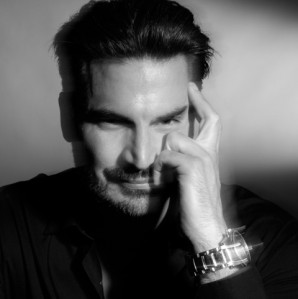TWELV takes a step back and visits the masterminds behind the camera.
JAE YONG KIM INTERVIEW “CERAMIC GENIUS”
“Ceramic Genius”
Korean-born artist JAE YONG KIM has come a long way from his days back in his homeland of Seoul, Korea. Having jetted off to major cities such as L.A, and the lovely continent of Europe, KIM has seen his way around the world. These days he has made a more permanent stop in New York City- a perfect hub for creating the quirky, humorous, and eclectic work that he is known for. Despite the playful nature of his artwork, KIM’s creations deal with his deep desire to understand and find his identity and the meaning of Home. He explores these serious issues in a unique way, expending his messages through whimsical sculptures of ceramic snails and donuts. In spite of his impressive resume, having received his Bachelors of Fine Arts in Ceramics and Sculpture at the University of Hartford, his Masters of Fine Arts in Ceramics at Cranbrook Academy of Art in Michigan, and showed his work in over 40 group exhibitions such as the “East & West Clay Works Exhibition,” KIM remains humble and driven. He also shares his passion and knowledge as a professor in the Department of Art and Design at Monclair State University. I caught up with the KIM at the iconic WATERFALLMANSION located in New York City’s Upper East Side where we discussed his life as an artist and mentor, and his undeniable passion for art. It was credible to soak it all in.
Kamara Williams: What were your incentives for coming to New York City?
Jae Yong Kim: I went to grad school in Michigan and after I graduated I went to LA, Chicago, then New York. When I was in Connecticut I got a lot of offers from museums and galleries but back then I was young and I was nervous about coming to New York as an artist. Because of that reason I wanted to try it out. I wanted to know what is it like to be an artist in New York. My curiosity and ambition brought me here.
KW:I know that you’ve moved around quite a bit in your life, so was it hard transitioning into life in New York?
JYK: Transitioning was basically getting used to new things such as different types of food, and clothing. I was getting used to all these things I needed to absorb. It was challenging to focus. It took me a while to focus on my work.
KW: How has your travels influenced your artwork?
JYK: I met this professor and he said one thing that he should have done more is travel. I agree on that because I travelled through Europe a couple of times and sometimes I revisit what I’ve seen there and then it influences my work ten years later, twenty years later. It’s needed, its like studying for me because I recall what I’ve seen when its time to create. There’s an artist named Bernini who made this sculpture of an elephant with an obelisk on top without understanding what an elephant looks like. It has a Dr. Seuss kind of finish. It’s very whimsical and very fun but yet all the details are there because that’s what he’s known for. I think that work influenced me a lot. It showed me that artwork could be fun as well. It doesn’t always have to be serious and if I weren’t travelling I probably wouldn’t have seen that.
KW: Would you say that travel influences your artwork subconsciously as well?
JYK: Sure. Everything you do influences something else.
KW:I know that you use the snail as a metaphor for home, where did that idea come from?
JYK: The snail metaphor came from searching for a home, a center. When you are in another country focusing on work home doesn’t really mean much. But at the same time it is needed. I was away from home and I was curious to see where I was going with my work. Those are the questions I had in my late 20s. For that reason I started finishing my snail artwork in chrome. I want people to be stronger. Through my snail artwork, I wanted to send the message that you just have to go forward. You don’t have to know where you are going. You might know unconsciously like snails do but it doesn’t have to be definite.
KW: Why did you choose a snail and not another animal for this metaphor?
JYK: I chose snails because it carries its home on its back. For me home became a verb. Home isn’t really a physical thing that you feel and go into to be comfortable. It is more of an act for me. When I work I feel like I’m home. It was necessary to use something like snails to represent that feeling. One of my earlier artworks is entitled “Snailing” shows moving became home because “snailing” means finding a home while carrying it on your back.
KW: You mentioned that you view home as a verb, Can you tell me more about that.
JYK: I feel most comfortable when I’m working. When you’re travelling so much nowhere feels like home. Even when I’m home it doesn’t feel like home. So if I’m in Korea I don’t feel like I’m home. But if I’m in the studio working then I’m most comfortable. I feel like that is where I’m supposed to be. That’s the reason I decided to be a sculptor because when I’m actually making something or doing something I love that act. Working became home.
KW: Did you always want to be an artist? How did you get to this point?
JYK: In my freshman year of high school I was in an after school class. One of my friends said, “ lets go to the modeling club” and I was like “what is the modeling club?” He said, “ I don’t know my friend’s in it.” I decided to go to the clay-modeling club and there we used to make sculptures out of clay. Freshman year, at my first show I had a moment where I realized oh wow this is something that I’m really good at and at that time I decided to be a sculptor. Since then it has never changed. I love to see how people react to my work.
KW: What are some of the upsides and downsides of your job?
JYK: Being an artist is a great job. Working with creative people who are just passionate about what they do for a living is such a joy. I do enjoy it. I usually work very late at night as well so that’s a little difficult. The downside is me fighting myself. I fight myself all the time, which makes means it just takes longer to get some place. But I do enjoy being an artist and making other people happy. When people see my work they see my struggle transformed into joy so I enjoy that moment when I‘m showing my art.
KW: When you say fighting yourself, do you mean to come up with an idea or choose between many ideas?
JYK: Ideas are not a difficult thing for me. I always have a sketchbook. It’s more of a question of how can I execute projects. For instance, since high school I always wanted to work on a public sculpture, which I haven’t done yet. So the ideas are there it’s more of a fighting with time. With the given time how much can I put out? That was the challenge and it’s still a bit of a challenge for me because one human being can only do so much.
KW: What does art mean to you?
JYK: Art is a language for me. It’s a language that has certain meanings if people understand it. And if they don’t it doesn’t mean anything. I’m a writer in a way because I write with my work. I communicate with my work so every characteristic it has means something. I think there is more to art than the psychical art form.
KW: I know you collaborate with other artists, what is that experience like? Do you prefer working on your own?
JYK: I believe there is not much you can do by yourself and I like to work as a team because of that reason. There’s a lot of limitation. I might act like I understand everything but I don’t. As you get older, the more you realize that you don’t know anything. Sometimes when I teach a certain subject matter I know exactly what I’m talking about. Other times clearly a student says I disagree and I have to think maybe they are right. I just turned 40 and there are so many things that I don’t know so it’s very important to work with other people in different fields and absorb what they can offer to the project.
KW: What was the inspiration behind your donut exhibit called “Blah Blah Blah”?
JYK: I made the donut exhibition when I was having the most difficult time as an artist. It was challenging for me to keep going in that direction because I now have a family now that I have to support, which is not an easy thing to do in New York City. So I looked into other businesses [besides art] to provide for my family. One of the businesses I looked into was a donut shop and we invested in that restaurant and lost all our money. I wanted to have an object that symbolized something that I wanted but if I have it I will lose focus. As an artist or as a human being when you have certain needs that are fulfilled you start thinking about something else. My ambition came through but at the same time I was questioning myself. I also spoke with a lot of successful people who have succeeded in their business in New York to try to understand how to make money. The more I listened to them the more I realized they were talking bullshit. They talked about their lifestyles such as living in an expensive apartment means something and I was like you know what? I don’t understand that language. They talked about numbers and income and I didn’t understand that language so I used donuts to make a statement to say that this is what I love made out of ceramics, this is what I care for, this is what I like. That became a language that they didn’t understand. That’s also the reason that I entitled it “Blah Blah Blah.” I thought it was a funny thing to call the exhibit “Blah Blah Blah” because the more I listened to people the more I realized that I didn’t know what they were trying to say. The donut exhibition really came from trying to survive and focus on my dreams.
KW: What is your creative process like?
JYK: For my creative process I do a lot of sketching and I take a lot of pictures. So even when I’m not focused on work I’m working. I’m always trying to develop my work. I work day and night from ten to three or ten to four at night with my assistant. I make a piece by making the clay then under glazing it so its like putting on clothes and then I fire it. It takes only three days to fire it and then I take it out and put on the clothing. After I apply the makeup, which is like the glaze on the front. Once that is done I do another firing and bring it back. If I like it I’ll glaze it. If I don’t like it I’ll put another under glaze. So it’s like looking at a mirror every time I fire. I just craft it until I’m happy. When I see a piece I’m satisfied with I’m like okay done. That’s a long process. It usually takes three to four firings.
KW: How long does it take to make one of the donuts?
JYK: If I’m making one donut it takes 10 – 11 days. But if I make 50 of them together that’s a little different story. If I do an order for someone it will take two weeks.
KW: What do you enjoy doing outside of work?
JYK: Teaching is my joy. I love working with students. I never really had a mentor. None of my family members are artists. They have professions such as doctors so I never had a mentor. I like to be a mentor and give a lot of advice so that my students don’t make the same kinds of mistakes that I made. I work very closely with them. Since I got educated in Korea my teaching style is kind of east and west so I mainly focus on basic skills then I move onto creative skills. Working with them always challenges me to develop more and more.
KW: What makes you most satisfied in life?
JYK: That’s a very good question. I like being an artist is. It makes me very happy because I’m still here doing what I want to do. I think about a lot of things that I had to go through to just stand still and work everyday as an artist and it’s amazing when I think about it. For some its just like “aww he’s just an artist” but for me to be in New York City working as an artist is quite amazing. So I have to say to myself wow good job.
KW: What advice would you give to young creatives?
JYK: I work with a lot of kids and I always tell them don’t complain, stop bitching about things and believe that one of your work can change the world. Just one single individual can the program, they can change themselves, they can change the university, and they can change the state. I’ve seen the power of artwork and they have that possibility but yet they don’t even understand what’s valuable. I think whenever you are creating art think of it as the last piece you are going to create.
KW: You said that you’ve seen the power of art; can you expand on that topic?
JYK: Earlier I talked about how art is like language. When you write about some artwork you can try to understand what it is by borrowing from art history or using certain words. But the aura that you feel and see from certain works no such word can explain that. Someone who can see and feel that will go back to their studio and make something close to what they have seen. There’s no such thing as understanding you just have to be in it and feel it. I believe everyone has that possibility. I’m talking to myself as well. I see art as a very powerful culture and I wonder do we even understand it? I think it’s more than an object to sell to make a living from.
KW: How would you describe yourself as an artist?
JYK: I’m just trying to have fun meaning life isn’t easy [laughs]. I want people to lighten up by looking at my work. At my first show, this kid brought a sketchbook and he was doing some drawing. I was looking at it and I was so happy to see this young kid trying to absorb my work. Then I decided this is the direction that I wanted to go in. From then my work started to be more cartoonish because my target is not adults necessarily. It’s more for the young. I don’t see them as a consumer but I just want to make them happy.
KW: How do you want people to remember you and your artwork in years to come?
JYK: I haven’t created the work yet to say I want you to remember me as this or that. I’m interested to see what kind of work I’m going to create in the future.
KW: Do you have any projects on the horizon?
JYK: For now I’m working on a large-scale donut. It’s the same as the small ones but I want it to be more powerful. One of the things I enjoy most about the small donuts is that is urges viewers to go in to see it. It’s almost like in a diary. It’s too small so I want it to be a little bigger. I want viewers to feel it as a painting, not as a donut. Scale isn’t that important but at the small size people have a very hard time seeing it for more than what it is so I want to challenge myself with this project.
WRITTEN BY: KAMARA WILLIAMS
PHOTOGRAPH: COLIN HUGHES
@waterfallmansion
related posts
IKEMEN #24: LUKE ABBY
IKEMEN (ē´k´mɛn): Japanese Slang
"REALLY, REALLY, RIDICULOUSLY GOOD LOOKING PEOPLE"
ERIN FETHERSTON EXCLUSIVE INTERVIEW
NAME: Erin Fetherston
ORIGIN: California
OCCUPATION: Fashion Designer
CRYSTAL KAY EXCLUSIVE INTERVIEW
NAME: Crystal Kay
ORIGIN: Yokohama, Japan
OCCUPATION: Performer and musician
IKEMEN #23: ANSONI
IKEMEN (ē´k´mɛn): Japanese Slang
"REALLY, REALLY, RIDICULOUSLY GOOD LOOKING PEOPLE"
IKEMEN #22: ADAM SPOONT
IKEMEN (ē´k´mɛn): Japanese Slang
"REALLY, REALLY, RIDICULOUSLY GOOD LOOKING PEOPLE"
BABËL New York Celebrates 1 Year Anniversary With Two Day Event of Excess and Splendor
BABEL NEW YORK acclaimed the NYC party scene in celebration of their First Year Anniversary. As temperatures begin to heat up in NYC, there is no better locale than the much desired rooftop.
BEHIND THE SCENES #2: LUIGI MURENU
TWELV's Behind the Scenes takes a step back and visits the masterminds behind the camera.
IKEMEN #21: MICHELLE VON MANDEL
IKEMEN (ē´k´mɛn): Japanese Slang
"REALLY, REALLY, RIDICULOUSLY GOOD LOOKING PEOPLE"
IKEMEN #20: GEORGE INAKI
IKEMEN (ē´k´mɛn): Japanese Slang
"REALLY, REALLY, RIDICULOUSLY GOOD LOOKING PEOPLE"
DEBORAH ANN WOLL: ALL THE WORLD'S A STAGE
Deborah Ann Woll’s voice glows when she speaks, as warm and full as her golden red hair.
NEVE CAMPBELL: LOSE YOURSELF TO DANCE
Carrying over two decades of the industry on her back, there aren’t many women with the grace and stoicism of Neve Campbell.
GARETH PUGH: ORGANIZED CHAOS
Gareth Pugh is a study in contrasts; balancing the demands of what is created and what is worn; what is in a designer’s control and what is in the hands of the wearer; what must be planned and...
LAKE BELL: THE GREAT LAKE
Lake Bell has made a name for herself as a charming, beautiful, and witty New Yorker capable of indie and blockbuster success (“It’s Complicated”, “No Strings Attached”, “Children’s Hospital...
FRIDAY'S FW PARTY
With Fashion Week’s second day over, Friday night was primetime for some of the most prominent designer to celebrate their successes over a glass of champagne.
IKEMEN #19: SAMAR SAJJAD
IKEMEN (ē´k´mɛn): Japanese Slang
"REALLY, REALLY, RIDICULOUSLY GOOD LOOKING PEOPLE"
Happy Birthday, Kate the Great!
Happy birthday to everyone’s favorite super model Kate Moss. The Brit enters her 40th year with grace, and she looks better than ever.
Lady Gaga's ArtPop Ball
Lady Gaga is back, and this time, it’s not just to perform.
IKEMEN #18: KEIICHIRO NAKAJIMA
IKEMEN (ē´k´mɛn): Japanese Slang
"REALLY, REALLY, RIDICULOUSLY GOOD LOOKING PEOPLE"
IKEMEN #16: KAROLYN PHO
IKEMEN (ē´k´mɛn): Japanese Slang
"REALLY, REALLY, RIDICULOUSLY GOOD LOOKING PEOPLE"
Futura Bold
Futura came up in the grimy, visceral environment of New York City’s early 1970’s street culture of tagging, bombing and writing graffiti – making their art not in the city, but on top of it.
FROM AUSTRALIA WITH LOVE: WHAT I'VE LEARNED SO FAR
Buyer’s Regret: It’s just like buyer’s remorse only in reverse. And it is a fashion crime that I have and will probably continue to commit time and time again.
IKEMEN #15: EDOARDO IANNUZZI
IKEMEN (ē´k´mɛn): Japanese Slang
"REALLY, REALLY, RIDICULOUSLY GOOD LOOKING PEOPLE"
FROM AUSTRALIA WITH LOVE: Designer Profile of Gabriella Ferrante
I find that Australia’s fashion industry can sometime be accused of playing catch-up with other, bigger and more cosmopolitan locations (i.e. Paris, London etc…) This needn’t be the case.
IKEMEN #14: Joao Veiga de Aguiar
IKEMEN (ē´k´mɛn): Japanese Slang
"REALLY, REALLY, RIDICULOUSLY GOOD LOOKING PEOPLE"
FROM AUSTRALIA WITH LOVE: PRETTY BOYS DON'T BUY THEIR OWN DRINKS
Its no secret if you know me – I like to drink.
IKEMEN #13: NATALIE O'BRIEN
IKEMEN (ē´k´mɛn): Japanese Slang
"REALLY, REALLY, RIDICULOUSLY GOOD LOOKING PEOPLE"
IKEMEN #12: KRISTIN PRIM
IKEMEN (ē´k´mɛn): Japanese Slang
"REALLY, REALLY, RIDICULOUSLY GOOD LOOKING PEOPLE"
ARTIST, MODEL, AND LIVING PIECE OF ART: ZOMBIE BOY
From Zombie Boy to living icon, Rick Genest isn’t just Nicola Formichetti’s muse anymore.
IKEMEN #11: JAY PAAVONPERA
IKEMEN (ē´k´mɛn): Japanese Slang
"REALLY, REALLY, RIDICULOUSLY GOOD LOOKING PEOPLE"
DON'T CALL DELANO BROWN A DESIGNER
TWELV met up with the always-unpredictable artist Delano Brown for lunch in Bryant Park.
IKEMEN #10: LOGAN NEITZEL
IKEMEN (ē´k´mɛn): Japanese Slang
"REALLY, REALLY, RIDICULOUSLY GOOD LOOKING PEOPLE"
Rocco Leo Gaglioti
Who are you?
Rocco Leo Gaglioti Creator/Host of Fashion News Live and Owner/CEO of RLG Productions, Corp.
NICOLA FORMICHETTI TUMBLR MEETUP HIGHLIGHTS
“My job feels more like a hobby than a job, really; it’s always fun,” says Nicola Formichetti for TWELV’s second issue.









































